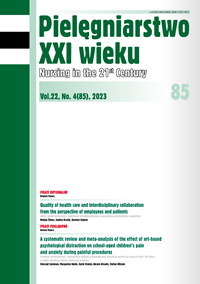Reporting the adverse events and healthcareassociated infections in relation to the work environment
DOI:
https://doi.org/10.2478/pielxxiw-2023-0036Keywords:
Health Facility Environment, infections, safety management, multicenter studyAbstract
REPORTING THE ADVERSE EVENTS AND HEALTHCAREASSOCIATED INFECTIONS IN RELATION TO THE WORK ENVIRONMENT
Aim. The aim of this multicenter study was to analyze the reporting of the adverse events and health care-associated infections (HAIs) in relation to work environment.
Material and methods. This cross-sectional multicenter study was conducted in 14 acute care hospitals throughout the Czech Republic. A total of 105 acute care hospital wards were included in the study. The Practice Environment Scale of the Nursing Work Index was used to assess the practice environment. The questionnaire to assess the practice environment were completed by 805 nurses. The data on adverse events and HAIs were weekly reported.
Results. The overall mean number of adverse events including healthcare-associated infections was 27.7 (±36.10) per 100 patients, the most frequent being pressure ulcers and falls. The most frequent healthcare-associated infections were urinary tract, gastrointestinal tract and surgical site infections. Analysis of all adverse events and HAIs failed to confirm a statistically significant relationship between the nursing practice environment and occurrence of adverse events or healthcare-associated infections.
Conclusions. Adverse events and healthcare-associated infections are important indicators of quality of care in hospitalized patients. No type of the nursing practice environment affected the reporting of adverse events and HAIs.
References
1. Rafter N, Hickey A, Condell S, et al. Adverse events in healthcare: learning from mistakes. QJM. 2015; 108(4): 273-277. doi: 10.1093/qjmed/hcu145.
2. Jindrak V, Prattingerova J, Hedlova D. [online]. Praha: National Institute of Public Health; 2012. [cit. 2021-11-14]. Present concept of the prevention and control of health care-associated infections. Part II: The scope, objectives, and methods of surveillance of health care-associated infections at local, national, and international levels. Centre for Epidemiology and Microbiology reports. Available from: http://www.szu.cz/uploads/documents/CeM/Zpravy_EM/21_2012/05_kveten/180_koncept_II.dil.pdf
3. System for Reporting Adverse Events [online]. Praha: System for Reporting Adverse Events; 2019 [cit. 2021-9-5]. Adverse events in 2019. Available from: https://shnu.uzis.cz/res/file/analyzy/shnu_data_2019_vysledky.pdf
4. Copanitsanou P, Fotos N, Brokalaki H. Effects of work environment on patient and nurse outcomes. Br. J. Nurs. 2017; 26(3): 172-176. doi: 10.12968/bjon.2017.26.3.172.
5. Al-Hamdan Z, Manojlovich M, Tanima B. Jordanian Nursing Work Environments, Intent to Stay, and Job Satisfaction. J. Nurs. Scholarsh. 2017; 49(1): 103-110. doi: 10.1111/jnu.12265.
6. Phillips LA, de Los Santos N, Jackson J. Licensed practical nurses’ perceptions of their work environments and their intention to stay: A cross-sectional study of four practice settings. Nurs. Open. 2021; 8(6): 3299-3305. doi: 10.1002/nop2.1046.
7. Aiken LH, Sloane DM, Clarke S, et al. Importance of work environments on hospital outcomes in nine countries. Int. J. Qual. Health Care. 2011; 23(4): 357-364. doi: 10.1093/intqhc/mzr022.
8. Roche MA, Duffield C, Friedman S, et al. Changes to nurses’ practice environment over time. J. Nurs. Manag. 2016; 24(5): 666-675. doi: 10.1111/jonm.12371.
9. Cho E, Chin DL, Kim S, et al. The Relationships of Nurse Staffing Level and Work Environment With Patient Adverse Events. J. Nurs. Scholarsh, 2016; 48(1): 74-82. doi: 10.1111/jnu.12183.
10. Choi S, Cho E, Kim E, et al. Effects of registered nurse staffing levels, work environment, and education levels on adverse events in nursing homes. Sci. Rep. 2021; 11(1): 21458. doi: 10.1038/s41598-021-00946-8.
11. Lake ET. Development of the practice environment scale of the Nursing Work Index. Res Nurs. Health. 2002; 25(3): 176-188. doi: 10.1002/nur.10032.
12. Lake ET, Friese CR. Variations in nursing practice environments: relation to staffing and hospital characteristics. Nurs. Res. 2006; 55(1): 1-9. doi: 10.1097/00006199-200601000-00001.
13. Beaton DE, Bombardier C, Guillemin F, et al. Guidelines for the process of crosscultural adaptation of self-report measures. Spine (Phila Pa 1976). 2000; 25(24): 3186-3191.
14. Zelenikova R, Jarošova D, Plevova I, et al. Vztah pracovniho prostředi sester a nedokončene ošetřovatelske peče – prvni vysledky vyzkumu v Česke republice. Zdravotnicke listy. 2021; 9(1): 12-18.
15. Joint Accreditation Commission of the Czech Republic [online]. Joint Accreditation Commission of the Czech Republic; 2019. [cit. 2021-9-5]. A new trend in care safety? Proactive risk prevention instead of mere counting of adverse events. Available from: https://www.sakcr.cz/page/news/245
16. Kang JH, Kim CW, Lee SY. Nurse-perceived patient adverse events and nursing practice environment. J. Prev. Med. Public Health. 2014; 47(5): 273-280. doi: 10.3961/jpmph.14.019.
17. Aiken LH, Sochalski J, Lake ET. Studying outcomes of organizational change in health services. Med. Care. 1997; 35(11): NS6-18. doi: 10.1097/00005650-199711001-00002.
18. International Council of Nurses [online]. Geneva: International Council of Nurses; 2012 [cit. 2021-11-5]. Patient safety. Available from: https://www.icn.ch/sites/default/fi les/inline-files/D05_Patient_Safety.pdf
19. World Health Organization [online]. World alliance for patient safety; Geneva, 2005 [cit. 2021-11-25]. WHO Draft guidelines for adverse event reporting and learning system: from information to patient. Available from: WHO-EIP-SPO-QPS-05.3-eng.pdf
20. Kalsi J, Arya M, Wilson P, et al. Hospital-acquired urinary tract infection. Int J Clin Pract, 2003; 57(5): 388-391.
21. Rasmussen K, Pedersen AH, Pape L, et al. Work environment influences adverse events in an emergency department. Dan. Med. J. 2014; 61(5): A4812.
22. Stalpers D, de Brouwer BJ, Kaljouw MJ, et al. Associations between characteristics of the nurse work environment and five nurse-sensitive patient outcomes in hospitals: a systematic review of literature. Int. J. Nurs. Stud. 2015; 52(4): 817-835. doi: 10.1016/j.ijnurstu.2015.01.005.
Downloads
Published
Issue
Section
License
Copyright (c) 2023 Authors

This work is licensed under a Creative Commons Attribution 4.0 International License.




